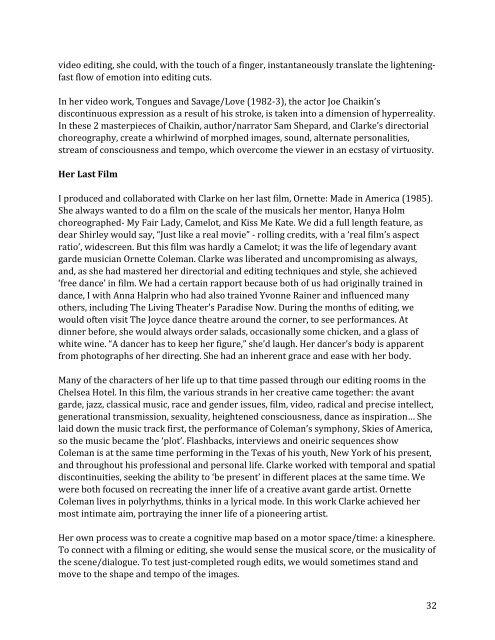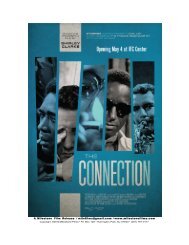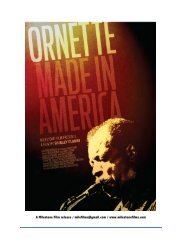ORNETTE Press Kit.8.7.2012 - Shirley Clarke
ORNETTE Press Kit.8.7.2012 - Shirley Clarke
ORNETTE Press Kit.8.7.2012 - Shirley Clarke
- No tags were found...
You also want an ePaper? Increase the reach of your titles
YUMPU automatically turns print PDFs into web optimized ePapers that Google loves.
video editing, she could, with the touch of a finger, instantaneously translate the lightening-fast flow of emotion into editing cuts. In her video work, Tongues and Savage/Love (1982-‐3), the actor Joe Chaikin’s discontinuous expression as a result of his stroke, is taken into a dimension of hyperreality. In these 2 masterpieces of Chaikin, author/narrator Sam Shepard, and <strong>Clarke</strong>’s directorial choreography, create a whirlwind of morphed images, sound, alternate personalities, stream of consciousness and tempo, which overcome the viewer in an ecstasy of virtuosity. Her Last Film I produced and collaborated with <strong>Clarke</strong> on her last film, Ornette: Made in America (1985). She always wanted to do a film on the scale of the musicals her mentor, Hanya Holm choreographed-‐ My Fair Lady, Camelot, and Kiss Me Kate. We did a full length feature, as dear <strong>Shirley</strong> would say, “Just like a real movie” -‐ rolling credits, with a ‘real film’s aspect ratio’, widescreen. But this film was hardly a Camelot; it was the life of legendary avant garde musician Ornette Coleman. <strong>Clarke</strong> was liberated and uncompromising as always, and, as she had mastered her directorial and editing techniques and style, she achieved ‘free dance’ in film. We had a certain rapport because both of us had originally trained in dance, I with Anna Halprin who had also trained Yvonne Rainer and influenced many others, including The Living Theater’s Paradise Now. During the months of editing, we would often visit The Joyce dance theatre around the corner, to see performances. At dinner before, she would always order salads, occasionally some chicken, and a glass of white wine. “A dancer has to keep her figure,” she’d laugh. Her dancer’s body is apparent from photographs of her directing. She had an inherent grace and ease with her body. Many of the characters of her life up to that time passed through our editing rooms in the Chelsea Hotel. In this film, the various strands in her creative came together: the avant garde, jazz, classical music, race and gender issues, film, video, radical and precise intellect, generational transmission, sexuality, heightened consciousness, dance as inspiration… She laid down the music track first, the performance of Coleman’s symphony, Skies of America, so the music became the ‘plot’. Flashbacks, interviews and oneiric sequences show Coleman is at the same time performing in the Texas of his youth, New York of his present, and throughout his professional and personal life. <strong>Clarke</strong> worked with temporal and spatial discontinuities, seeking the ability to ‘be present’ in different places at the same time. We were both focused on recreating the inner life of a creative avant garde artist. Ornette Coleman lives in polyrhythms, thinks in a lyrical mode. In this work <strong>Clarke</strong> achieved her most intimate aim, portraying the inner life of a pioneering artist. Her own process was to create a cognitive map based on a motor space/time: a kinesphere. To connect with a filming or editing, she would sense the musical score, or the musicality of the scene/dialogue. To test just-‐completed rough edits, we would sometimes stand and move to the shape and tempo of the images. 32




